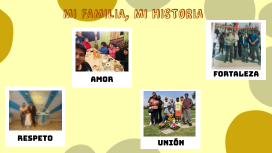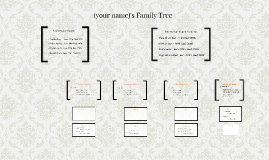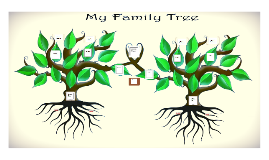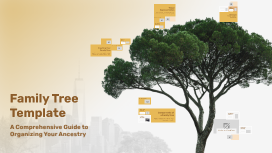Family Tree Template
Transcript: Family History Preservation Techniques Utilizing archival-quality materials, such as acid-free paper and protective covers, will help safeguard family documents and photographs. Digital archiving options include scanning documents, using genealogy software, and backing up data on cloud services for long-term security. Tips for Sharing with Family Members Digital vs. Physical Copies Visual Representation Engaging family members in conversations about their stories and memories can enrich the family tree. Consider hosting a family reunion or creating a shared online platform where relatives can contribute their history, updates, and photographs. Digital copies of family trees are easily shared and backed up, providing accessibility across devices. Physical copies, such as printed trees or illustrated charts, offer a tangible experience, often cherished during family gatherings and passed down as heirlooms. Effective visual representation is crucial in crafting a family tree. This section focuses on how different diagram formats, color coding, and personal touches can enhance understanding and engagement in your genealogy project. Sharing and Preserving Your Family Tree Diagram Formats Adding Images and Personal Touches Sharing and preserving your family tree ensures the legacy of your ancestry is maintained and enjoyed by future generations. Understanding the methods available, from digital solutions to physical memorabilia, can enhance the experience of exploring one's heritage. There are several common diagram formats used in family trees including pedigree charts, descendant charts, and family group sheets. Each format serves a purpose, with pedigree charts focusing on direct ancestors and descendant charts illustrating lineage. Incorporating images of family members, birth certificates, and heirloom photographs personalizes the family tree. This not only enriches the visual appeal but also creates a tangible connection to family history. Color Coding Relationships Color coding enhances clarity and allows for immediate recognition of relationship types such as immediate family, cousins, or distant relatives. Utilizing different colors can reduce confusion, especially in extended families. Tools and Resources for Creating Trees Collecting Family Information Utilizing specialized tools enhances the family tree-building experience. Online platforms like Ancestry.com, FamilySearch, and software applications like Family Tree Maker provide templates, research assistance, and collaboration options for families. Gathering accurate ancestral information is crucial for a valid family tree. Interview family members, access public records, and utilize genealogical databases to compile essential data, including birthdates, marriages, and significant events. Choosing a Template Selecting a template suited to your family structure streamlines the creation process. Various formats are available, including traditional charts and modern digital designs, ensuring that the chosen template aligns with your family's story and preferences. Creating Your Family Tree Building a family tree requires thoughtful planning, resource gathering, and the right tools. This section outlines key steps to create a comprehensive family tree that effectively captures your ancestry. Key Relationships Key relationships form the backbone of a family tree, featuring parents, siblings, and extended family such as aunts and uncles. Accurately mapping these relationships helps create a clear visual representation of family ties and lineage. Family Tree Template Jocoqu Generational structure is critical for understanding lineage and ancestry, often represented through multiple generations in a vertical format. This structure illustrates how family members relate across generations, highlighting direct descendants and ancestors. Importance of Family Trees Components of a Family Tree Family trees are vital for preserving heritage, connecting generations, and providing identity. They facilitate the exploration of one's origins, helping individuals understand cultural backgrounds and familial ties. Personal Information Understanding the essential elements such as key relationships, generational structures, and personal information significantly enhances the accuracy and depth of a family tree. These components form the framework that allows individuals to trace their ancestry effectively. Incorporating personal information such as birthdates and marriage details is essential for each family member in a tree. This data enriches the genealogy, enabling a more comprehensive understanding of each individual's role and history within the family. Overview of Genealogy Introduction to Family Trees A Comprehensive Guide to Organizing Your Ancestry Genealogy is the study of family histories, utilizing documents, oral traditions, and DNA testing to trace lineage. It plays a crucial role in connecting individuals to their roots and understanding familial dynamics.

















